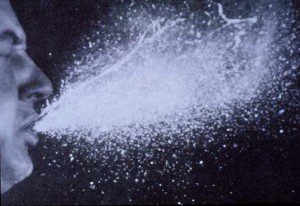

Respiratory transmission depends upon the production of aerosols that contain virus particles. Speaking, singing, and normal breathing all produce aerosols, while coughing and sneezing lead to more forceful expulsion. While coughing may produce several hundred droplets, a good sneeze can generate up to 20,ooo. Aerosolized particles produced by these activities are of different sizes. The largest droplets fall to the ground within a few meters and will transmit an infection only to those in the immediate vicinity. Other droplets travel a distance determined by their size. Those droplets 1-4 microns in diameter are called ‘droplet nuclei’; these remain suspended in the air for very long periods and may not only travel long distances, but can reach the lower respiratory tract. Inhalation of droplets and droplet nuclei places virus in the upper respiratory tract, where it may initiate infection.
The importance of aerosol transmission is illustrated by an outbreak of influenza aboard a commercial airplane in the late 1970s. The plane, carrying 54 persons, was delayed on the ground for three hours, during which time the ventilation system was not functional. Most of the travelers remained on board. Within 72 hours, nearly 75% of the passengers developed influenza. The source of the infection was a single person on the airplane with influenza.
Nasal secretions, which contain virus particles, are responsible for transmission by direct contact or by contaminated objects. An infected person will frequently touch their nose or conjunctiva, placing virus on the hand. Intimate or non-intimate contact (e.g. shaking hands) will transfer the virus to another person, who will then infect themselves by touching their nose or eyes. When contaminated hands touch other objects, the virus is transferred to them. In one study, 23-59% of objects from homes and day care facilities were shown to harbor influenza viral RNA. Others have shown that infectious influenza virus may be persist on paper currency for several weeks.
Influenza transmission can be reduced by covering your nose and mouth when coughing or sneezing, and by washing hands often with soap and water or alcohol-based hand cleaners. Note that CDC does not recommend the use of face masks for reducing viral spread. It is important to recognize that, in human infections, maximum levels of virus shedding may occur about a day before the peak of symptoms.
Ethical considerations preclude controlled influenza virus transmission studies in humans, and therefore animal models must be used. Ferrets are susceptible to many strains of influenza virus, and develop symptoms similar to those in humans. However these animals are costly and difficult to house, precluding their use in most large scale transmission studies. The guinea pig has recently been described as an alternative animal model for studying influenza virus transmission. These animals are susceptible to different viral strains, and the virus replicates to high titers in the respiratory tract. The guinea pig was used to show that transmission of influenza virus occurs by aerosols and through contaminated environmental surfaces. The efficiency of aerosol transmission in the guinea pig model is regulated by temperature and humidity.
Fabian, P., McDevitt, J., DeHaan, W., Fung, R., Cowling, B., Chan, K., Leung, G., & Milton, D. (2008). Influenza Virus in Human Exhaled Breath: An Observational Study PLoS ONE, 3 (7) DOI: 10.1371/journal.pone.0002691
Carrat, F., Vergu, E., Ferguson, N., Lemaitre, M., Cauchemez, S., Leach, S., & Valleron, A. (2008). Time Lines of Infection and Disease in Human Influenza: A Review of Volunteer Challenge Studies American Journal of Epidemiology, 167 (7), 775-785 DOI: 10.1093/aje/kwm375
Mubareka, S., Lowen, A., Steel, J., Coates, A., GarcÃa€Sastre, A., & Palese, P. (2009). Transmission of Influenza Virus via Aerosols and Fomites in the Guinea Pig Model The Journal of Infectious Diseases, 199 (6), 858-865 DOI: 10.1086/597073

Comments are closed.